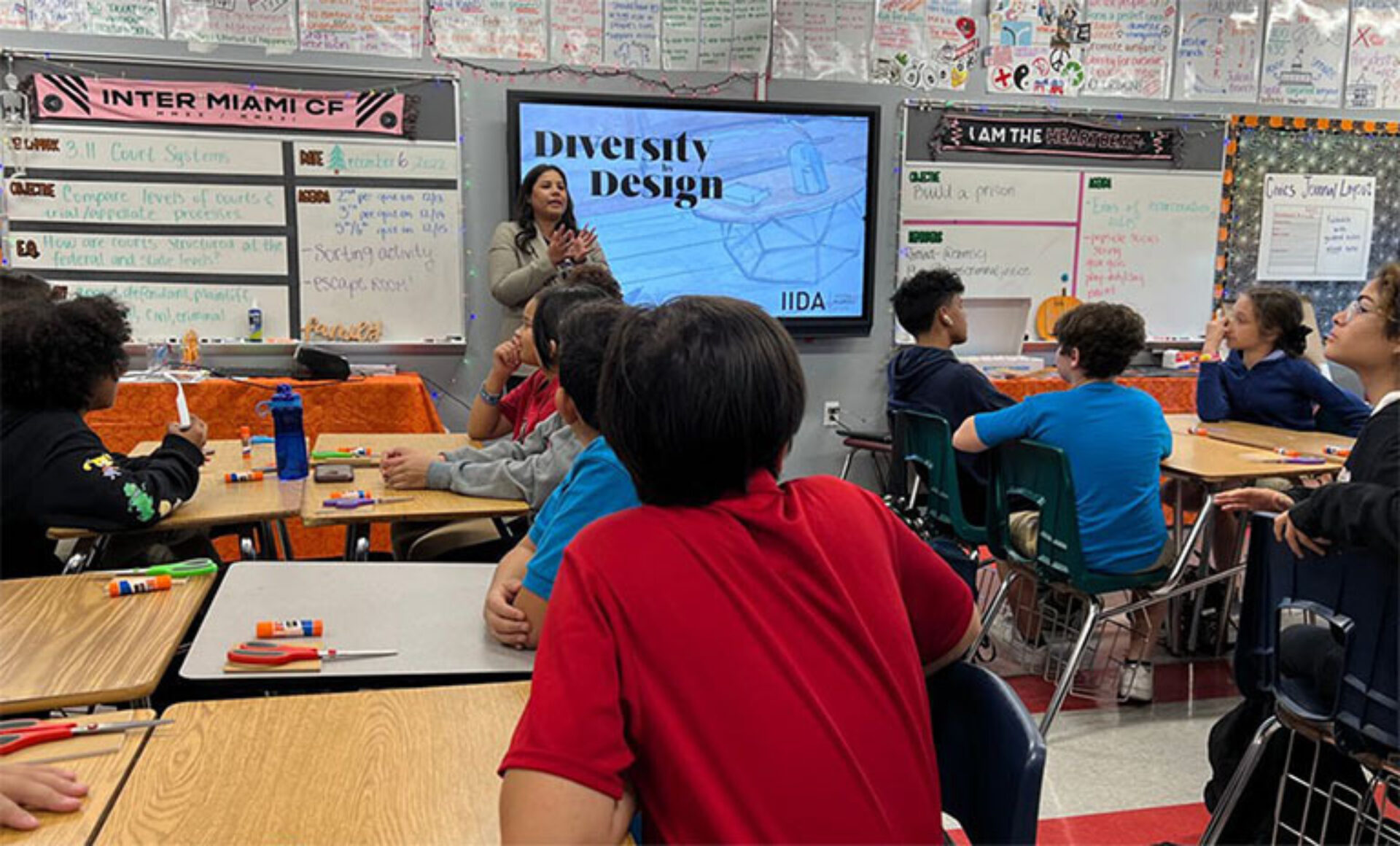(Above: Celebrating the signing of SF 135 in Iowa Governor Kim Reynolds' office. Image courtesy of Lisa Schettler)
This past April Iowa Governor Kim Reynolds signed Senate File 135 (SF 135) into law. This bill defines registered interior design as the design of interior spaces as a part of an interior alteration or construction project including the preparation of interior technical submissions relating to space planning, finish materials, furnishings, fixtures, and equipment, and the preparation of documents relating to interior construction that does not affect the engineered systems of a building. In short: it confirms the key role interior design plays in the built environment and reinforces the critical role of interior designers as stewards of health, safety, and well-being. To celebrate this big win, Lisa Schettler, IIDA, former VP of Advocacy for Iowa (IIDA Great Plains Chapter), and interior design group leader at Shive-Hattery discusses the importance of this historic moment, their advocacy journey, and the Chapter’s future plans.
Tell us a bit about the passing of Senate File 135: how will this legislation impact your work and the work of your fellow Iowa practitioners?
On July 1, 2023, Registered Interior Designers (RID) in Iowa will be able to stamp and seal their interior technical submissions for a permit review. They will no longer need a licensed architect to review and stamp their drawings. The scope of work allowed by the new law is carefully described, bringing RID into the 21st century to more fully reflect what a registered interior designer does. The new law is voluntary and does not preclude anyone from calling themselves an interior designer, so residential designers, kitchen and bath designers, and decorators will continue to do their work unchanged. The new scope of work does not include building envelope modifications, seismic or structural changes, or modifications to the engineered systems of the building. The law does not diminish an architect’s role.

This advocacy victory is the result of four years work. What do you think was the catalyst for your success this year?
The National Council of Architectural Registration Boards (NCARB) and NCIDQ Joint Report and subsequent revision to the American Institute of Architects (AIA)’s national position statement regarding interior design legislation opened the door to successful collaboration between AIA Iowa and IIDA Great Plains Chapter. Representatives from both local organizations spent considerable time together carefully crafting the language of SF 135 to refine what is appropriate for a RID to take professional responsibility for and what is not within that scope. The resulting document is stronger because of this collaboration, which is a great example of how architects and interior designers collaborate on client projects.
Also important were the previous years spent building relationships with legislators and educating them about Commercial Interior Design and why this legislation is important in protecting the well-being of the public in the built environment.
What were the greatest challenges, and what surprised you most about the process?
One challenge was to educate the public (including legislators) on what commercial interior design is. They don’t understand the technical nature of what we do and how many codes and regulations we need to adhere to, in addition to making the space look great. Another huge challenge in the first couple of years was the fierce opposition we faced from the AIA at the state capitol. It was surprising and disheartening to see and hear many architecture colleagues speaking against interior design legislation and the profession.
Can you share a piece of advice for other advocacy teams that are working towards passing similar bills?
Jump in with both feet. Don’t study the issue to death and try to get everything perfect before introducing legislation. We have good bill language that has been successful in a few states already. Use that as a starting point and run! You will learn and adapt as you go. Know that it will probably take years if starting from scratch. Be in it for the long haul, even if a major pandemic hits.
You must have a lobbyist! Work with the party in power in your state legislature. It’s often the only way to get a grassroots bill passed. Go to their fundraisers, coffee chats, and town halls with your lobbyist. Make a personal donation—if you wish. One thing that really helped us was making strong connections with a couple of key legislators: one Senator and one Representative. RIDs from their districts were able to speak with them one-on-one about our bill and show them the work we do. It really opened their eyes as to why this legislation makes sense.

Try to build relationships with your local AIA representatives. There may be difficult conversations and you may find out some things you wish you didn’t know but at least you can say that you tried to work together. And maybe it will lead to great things as it did in Iowa. Once we removed this opposition, the bill sailed through. You probably can’t have anyone registered “against” your bill and get it passed easily.
You will have to educate legislators about what commercial interior design is—how it is necessary to get building permits and prove code compliance and that this is only part of why we need signed/sealed drawings. (Remember: they think it is HGTV or someone decorating their mantle!) Talk about the economic benefits of this bill to legislators including opening up competition, stimulating small business creation as the business practice is streamlined, and keeping students that are educated in our state here with fulfilling career possibilities. Talk about how it is VOLUNTARY and “opt-in.” We did a title act with permitting privileges—not a practice act. There is a subtle but important distinction between the two and generally the former is preferred. DO NOT talk about how this will protect our profession or anything like that! This is about how registered interior designers can protect the health, safety, and well-being of the public in the built environment. Nothing more!
You’re stepping down from your role as VP of Advocacy—what’s next for you and for the IIDA Iowa Advocacy team?
The next steps for Iowa are to educate RIDs, architects, and code officials about what RIDs may and may not sign for, and to increase our registration numbers now that the registration allows us to stamp and seal technical submissions, making it more relevant.
I have applied to be on the Iowa Interior Design Examining Board but am not sure when that vacancy will be filled. Also, I’m not going anywhere and will still be involved with advocating for the profession and educating others about our new law. I’m very proud of what we have achieved in our state!






